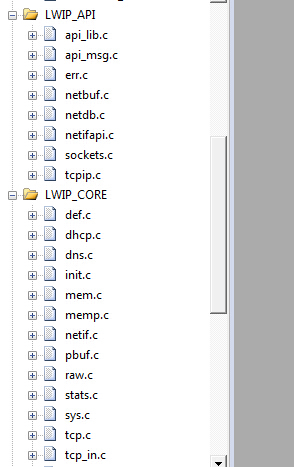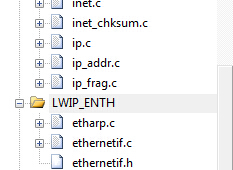LWIP是一款开源的嵌入式网络协议栈,支持的功能很多,而且能在多任务环境下和单任务裸机环境下跑,今天说说他的移植过程,芯片为STM32,网卡为ENC28J60,无操作系统
首先下载LWIP的源代码,我下载的是1.4.1的源码,下载后解压,文件结构如图

将这四个目录中的文件全部拷贝到工程中,API是一些socket通讯的接口,需要在多任务的环境下实现,core里面存放的内核源码,我们主要使用IPV4,include目录下是需要包含的目录,lwip只要求我们包含include目录,里面的内层目录会自动找到,最后建立的工程目录如下



好了,此时源码已经做好,还有需要做的,在include目录下新建一个文件夹,必须叫arch,里面存放这几个文件,自己新建

文件的具体内容如下
cc.h
/* * Copyright (c) 2001-2003 Swedish Institute of Computer Science. * All rights reserved. * * Redistribution and use in source and binary forms, with or without modification, * are permitted provided that the following conditions are met: * * 1. Redistributions of source code must retain the above copyright notice, * this list of conditions and the following disclaimer. * 2. Redistributions in binary form must reproduce the above copyright notice, * this list of conditions and the following disclaimer in the documentation * and/or other materials provided with the distribution. * 3. The name of the author may not be used to endorse or promote products * derived from this software without specific prior written permission. * * THIS SOFTWARE IS PROVIDED BY THE AUTHOR ``AS IS'' AND ANY EXPRESS OR IMPLIED * WARRANTIES, INCLUDING, BUT NOT LIMITED TO, THE IMPLIED WARRANTIES OF * MERCHANTABILITY AND FITNESS FOR A PARTICULAR PURPOSE ARE DISCLAIMED. IN NO EVENT * SHALL THE AUTHOR BE LIABLE FOR ANY DIRECT, INDIRECT, INCIDENTAL, SPECIAL, * EXEMPLARY, OR CONSEQUENTIAL DAMAGES (INCLUDING, BUT NOT LIMITED TO, PROCUREMENT * OF SUBSTITUTE GOODS OR SERVICES; LOSS OF USE, DATA, OR PROFITS; OR BUSINESS * INTERRUPTION) HOWEVER CAUSED AND ON ANY THEORY OF LIABILITY, WHETHER IN * CONTRACT, STRICT LIABILITY, OR TORT (INCLUDING NEGLIGENCE OR OTHERWISE) ARISING * IN ANY WAY OUT OF THE USE OF THIS SOFTWARE, EVEN IF ADVISED OF THE POSSIBILITY * OF SUCH DAMAGE. * * This file is part of the lwIP TCP/IP stack. * * Author: Adam Dunkels <adam@sics.se> * */ #ifndef __CC_H__ #define __CC_H__ #include "cpu.h" //编译器无关的数据类型定义 typedef unsigned char u8_t; typedef signed char s8_t; typedef unsigned short u16_t; typedef signed short s16_t; typedef unsigned long u32_t; typedef signed long s32_t; typedef u32_t mem_ptr_t; typedef int sys_prot_t; //lwip调试的时候数据类型定义 #define U16_F "hu" #define S16_F "d" #define X16_F "hx" #define U32_F "u" #define S32_F "d" #define X32_F "x" #define SZT_F "uz" //根据不同的编译器的符号定义 #if defined (__ICCARM__) #define PACK_STRUCT_BEGIN #define PACK_STRUCT_STRUCT #define PACK_STRUCT_END #define PACK_STRUCT_FIELD(x) x #define PACK_STRUCT_USE_INCLUDES #elif defined (__CC_ARM) #define PACK_STRUCT_BEGIN __packed #define PACK_STRUCT_STRUCT #define PACK_STRUCT_END #define PACK_STRUCT_FIELD(x) x #elif defined (__GNUC__) #define PACK_STRUCT_BEGIN #define PACK_STRUCT_STRUCT __attribute__ ((__packed__)) #define PACK_STRUCT_END #define PACK_STRUCT_FIELD(x) x #elif defined (__TASKING__) #define PACK_STRUCT_BEGIN #define PACK_STRUCT_STRUCT #define PACK_STRUCT_END #define PACK_STRUCT_FIELD(x) x #endif #define LWIP_PLATFORM_ASSERT(x) //do { if(!(x)) while(1); } while(0) #endif /* __CC_H__ */
cpu.h
/* * Copyright (c) 2001-2003 Swedish Institute of Computer Science. * All rights reserved. * * Redistribution and use in source and binary forms, with or without modification, * are permitted provided that the following conditions are met: * * 1. Redistributions of source code must retain the above copyright notice, * this list of conditions and the following disclaimer. * 2. Redistributions in binary form must reproduce the above copyright notice, * this list of conditions and the following disclaimer in the documentation * and/or other materials provided with the distribution. * 3. The name of the author may not be used to endorse or promote products * derived from this software without specific prior written permission. * * THIS SOFTWARE IS PROVIDED BY THE AUTHOR ``AS IS'' AND ANY EXPRESS OR IMPLIED * WARRANTIES, INCLUDING, BUT NOT LIMITED TO, THE IMPLIED WARRANTIES OF * MERCHANTABILITY AND FITNESS FOR A PARTICULAR PURPOSE ARE DISCLAIMED. IN NO EVENT * SHALL THE AUTHOR BE LIABLE FOR ANY DIRECT, INDIRECT, INCIDENTAL, SPECIAL, * EXEMPLARY, OR CONSEQUENTIAL DAMAGES (INCLUDING, BUT NOT LIMITED TO, PROCUREMENT * OF SUBSTITUTE GOODS OR SERVICES; LOSS OF USE, DATA, OR PROFITS; OR BUSINESS * INTERRUPTION) HOWEVER CAUSED AND ON ANY THEORY OF LIABILITY, WHETHER IN * CONTRACT, STRICT LIABILITY, OR TORT (INCLUDING NEGLIGENCE OR OTHERWISE) ARISING * IN ANY WAY OUT OF THE USE OF THIS SOFTWARE, EVEN IF ADVISED OF THE POSSIBILITY * OF SUCH DAMAGE. * * This file is part of the lwIP TCP/IP stack. * * Author: Adam Dunkels <adam@sics.se> * */ #ifndef __CPU_H__ #define __CPU_H__ //定义cpu的数据模式,大端小端 #define BYTE_ORDER LITTLE_ENDIAN #endif /* __CPU_H__ */
perf.h
#ifndef __PERF_H__ #define __PERF_H__ //用于lwip内置的统计功能 //不使能定义为空就可以了 #define PERF_START /* null definition */ #define PERF_STOP(x) /* null definition */ #endif /* __PERF_H__ */
sys_arch.h
#ifndef __SYS_RTXC_H__ #define __SYS_RTXC_H__ void init_lwip_timer(void); //初始化LWIP定时器 u8_t timer_expired(u32_t *last_time,u32_t tmr_interval); //定时器超时判断 #endif /* __SYS_RTXC_H__ */
sya_arch.c--注意该文件要加入源文件列表中,这是c文件哦
#include "lwip/debug.h" #include "lwip/def.h" #include "lwip/sys.h" #include "lwip/mem.h" #include "timerx.h" //初始化LWIP定时器 void init_lwip_timer(void) { TIM6_Int_Init(1000,719);//100Khz计数频率,计数到100为10ms } //为LWIP提供计时 extern u32_t lwip_timer;//lwip 计时器,每10ms增加1. u32_t sys_now(void) { return lwip_timer; } //定时器超时判断 //last_time:最近时间 //tmr_interval:定时器溢出周期 u8_t timer_expired(u32_t *last_time,u32_t tmr_interval) { u32_t time; time = *last_time; if((lwip_timer-time)>=tmr_interval){ *last_time = lwip_timer; return 1; } return 0; }
可以看到我们定义了定时器,那么就要修改相关的定时器文件,文件如下
timerx.c
#include "timerx.h" u32 lwip_timer=0;//lwip 计时器,每10ms增加1. //定时器6中断服务程序 void TIM6_IRQHandler(void) { if (TIM_GetITStatus(TIM6, TIM_IT_Update) != RESET) //检查指定的TIM中断发生与否:TIM 中断源 { TIM_ClearITPendingBit(TIM6, TIM_IT_Update ); //清除TIMx的中断待处理位:TIM 中断源 lwip_timer++;//lwip计时器增加1 } } //基本定时器6中断初始化 //这里时钟选择为APB1的2倍,而APB1为36M //arr:自动重装值。 //psc:时钟预分频数 //这里使用的是定时器3! void TIM6_Int_Init(u16 arr,u16 psc) { TIM_TimeBaseInitTypeDef TIM_TimeBaseStructure; NVIC_InitTypeDef NVIC_InitStructure; RCC_APB1PeriphClockCmd(RCC_APB1Periph_TIM6, ENABLE); //时钟使能 TIM_TimeBaseStructure.TIM_Period = arr; //设置在下一个更新事件装入活动的自动重装载寄存器周期的值 计数到5000为500ms TIM_TimeBaseStructure.TIM_Prescaler =psc; //设置用来作为TIMx时钟频率除数的预分频值 10Khz的计数频率 TIM_TimeBaseStructure.TIM_ClockDivision = 0; //设置时钟分割:TDTS = Tck_tim TIM_TimeBaseStructure.TIM_CounterMode = TIM_CounterMode_Up; //TIM向上计数模式 TIM_TimeBaseInit(TIM6, &TIM_TimeBaseStructure); //根据TIM_TimeBaseInitStruct中指定的参数初始化TIMx的时间基数单位 TIM_ITConfig( TIM6,TIM_IT_Update|TIM_IT_Trigger,ENABLE);//使能定时器6更新触发中断 TIM_Cmd(TIM6, ENABLE); //使能TIMx外设 NVIC_InitStructure.NVIC_IRQChannel = TIM6_IRQn; //TIM3中断 NVIC_InitStructure.NVIC_IRQChannelPreemptionPriority = 1; //先占优先级0级 NVIC_InitStructure.NVIC_IRQChannelSubPriority = 2; //从优先级3级 NVIC_InitStructure.NVIC_IRQChannelCmd = ENABLE; //IRQ通道被使能 NVIC_Init(&NVIC_InitStructure); //根据NVIC_InitStruct中指定的参数初始化外设NVIC寄存器 }
timerx.h
#ifndef __TIMER_H_ #define __TIMER_H_ #include "sys.h" void TIM6_Int_Init(u16 arr,u16 psc); #endif
好了,这个时候移植就基本完成了,但是编译是过不了的,因为我们缺少一个配置文件.h,这个文件放哪都可以,只要工程包含这个文件的目录,另外,该文件名称不能改动
lwipopts.h
#ifndef __LWIPOPTS_H__ #define __LWIPOPTS_H__ //回环模式 //#define LWIP_HAVE_LOOPIF 1 /* Prevent having to link sys_arch.c (we don't test the API layers in unit tests) */ #define NO_SYS 1 //是否使用操作系统 #define LWIP_NETCONN 0 #define LWIP_SOCKET 0 #define LWIP_DHCP 1 //使能DHCP模块 #define MEM_ALIGNMENT 4 //必须4字节对齐 曾出现在memset的时候hardfault #define LWIP_DNS 1 #define MEM_SIZE 16000 //使用多大一块内存做lwip内存 #define TCP_SND_QUEUELEN 40 //tcp发送序列长度 #define MEMP_NUM_TCP_SEG TCP_SND_QUEUELEN #define TCP_MSS 1460 #define TCP_WND (4 * TCP_MSS) #define TCP_SND_BUF (8 * TCP_MSS) #define ETHARP_SUPPORT_STATIC_ENTRIES 1 #endif /* __LWIPOPTS_H__ */
可以看到,我们没有使用操作系统并且使能了dhcp功能
这时候就可以编译通过了,但是还有一个必须做的工作,移植网卡的驱动到lwip中,
也就是netif文件夹中的ethernetif.c文件,该文件修改为如下内容
//网卡驱动层文件 #if 1 /* don't build, this is only a skeleton, see previous comment */ #include "lwip/def.h" #include "lwip/mem.h" #include "lwip/pbuf.h" #include <lwip/stats.h> #include <lwip/snmp.h> #include "netif/etharp.h" #include "netif/ppp_oe.h" #include "enc28j60.h" #include "netif/ethernetif.h" #include "string.h" #include "delay.h" /* Define those to better describe your network interface. */ #define IFNAME0 'e' #define IFNAME1 'n' //MAC地址 const u8 mymac[6]={0x99,0x02,0x35,0x04,0x45,0x61}; //MAC地址 //定义发送接受缓冲区 u8 lwip_buf[1500*2]; //返回网卡地址 struct ethernetif { struct eth_addr *ethaddr; /* Add whatever per-interface state that is needed here. */ }; //网卡的初始化 static err_t low_level_init(struct netif *netif) { //mac地址 netif->hwaddr_len = ETHARP_HWADDR_LEN; /* set MAC hardware address */ netif->hwaddr[0] = mymac[0]; netif->hwaddr[1] = mymac[1]; netif->hwaddr[2] = mymac[2]; netif->hwaddr[3] = mymac[3]; netif->hwaddr[4] = mymac[4]; netif->hwaddr[5] = mymac[5]; //最大传输单元 netif->mtu = MAX_FRAMELEN; if(ENC28J60_Init((u8*)mymac)) //初始化ENC28J60 { return ERR_IF; //底层网络接口错误 } //指示灯状态:0x476 is PHLCON LEDA(绿)=links status, LEDB(红)=receive/transmit //PHLCON:PHY 模块LED 控制寄存器 ENC28J60_PHY_Write(PHLCON,0x0476); netif->flags = NETIF_FLAG_BROADCAST | NETIF_FLAG_ETHARP | NETIF_FLAG_LINK_UP; return ERR_OK; } //从指定网卡输出一部分数据 static err_t low_level_output(struct netif *netif, struct pbuf *p) { struct pbuf *q; int send_len=0; #if ETH_PAD_SIZE pbuf_header(p, -ETH_PAD_SIZE); /* drop the padding word */ #endif for(q = p; q != NULL; q = q->next) { /* Send the data from the pbuf to the interface, one pbuf at a time. The size of the data in each pbuf is kept in the ->len variable. */ //send data from(q->payload, q->len); memcpy((u8_t*)&lwip_buf[send_len], (u8_t*)q->payload, q->len); send_len +=q->len; } // signal that packet should be sent(); ENC28J60_Packet_Send(send_len,lwip_buf); #if ETH_PAD_SIZE pbuf_header(p, ETH_PAD_SIZE); /* reclaim the padding word */ #endif LINK_STATS_INC(link.xmit); return ERR_OK; } //从指定网卡读取一帧数据回来 static struct pbuf *low_level_input(struct netif *netif) { // struct ethernetif *ethernetif = netif->state; struct pbuf *p, *q; u16_t len; int rev_len=0; /* Obtain the size of the packet and put it into the "len" variable. */ len = ENC28J60_Packet_Receive(MAX_FRAMELEN,lwip_buf); #if ETH_PAD_SIZE len += ETH_PAD_SIZE; /* allow room for Ethernet padding */ #endif /* We allocate a pbuf chain of pbufs from the pool. */ p = pbuf_alloc(PBUF_RAW, len, PBUF_POOL); if (p != NULL) { #if ETH_PAD_SIZE pbuf_header(p, -ETH_PAD_SIZE); /* drop the padding word */ #endif /* We iterate over the pbuf chain until we have read the entire * packet into the pbuf. */ for(q = p; q != NULL; q = q->next) { /* Read enough bytes to fill this pbuf in the chain. The * available data in the pbuf is given by the q->len * variable. * This does not necessarily have to be a memcpy, you can also preallocate * pbufs for a DMA-enabled MAC and after receiving truncate it to the * actually received size. In this case, ensure the tot_len member of the * pbuf is the sum of the chained pbuf len members. */ //read data into(q->payload, q->len); memcpy((u8_t*)q->payload, (u8_t*)&lwip_buf[rev_len],q->len); rev_len +=q->len; } // acknowledge that packet has been read(); #if ETH_PAD_SIZE pbuf_header(p, ETH_PAD_SIZE); /* reclaim the padding word */ #endif LINK_STATS_INC(link.recv); } else { //drop packet(); LINK_STATS_INC(link.memerr); LINK_STATS_INC(link.drop); } return p; } /** * This function should be called when a packet is ready to be read * from the interface. It uses the function low_level_input() that * should handle the actual reception of bytes from the network * interface. Then the type of the received packet is determined and * the appropriate input function is called. * * @param netif the lwip network interface structure for this ethernetif */ void ethernetif_input(struct netif *netif) { // struct ethernetif *ethernetif; struct eth_hdr *ethhdr; struct pbuf *p; // ethernetif = netif->state; /* move received packet into a new pbuf */ p = low_level_input(netif); /* no packet could be read, silently ignore this */ if (p == NULL) return; /* points to packet payload, which starts with an Ethernet header */ ethhdr = p->payload; switch (htons(ethhdr->type)) { /* IP or ARP packet? */ case ETHTYPE_IP: case ETHTYPE_ARP: #if PPPOE_SUPPORT /* PPPoE packet? */ case ETHTYPE_PPPOEDISC: case ETHTYPE_PPPOE: #endif /* PPPOE_SUPPORT */ /* full packet send to tcpip_thread to process */ if (netif->input(p, netif)!=ERR_OK) { LWIP_DEBUGF(NETIF_DEBUG, ("ethernetif_input: IP input error ")); pbuf_free(p); p = NULL; } break; default: pbuf_free(p); p = NULL; break; } } /** * Should be called at the beginning of the program to set up the * network interface. It calls the function low_level_init() to do the * actual setup of the hardware. * * This function should be passed as a parameter to netif_add(). * * @param netif the lwip network interface structure for this ethernetif * @return ERR_OK if the loopif is initialized * ERR_MEM if private data couldn't be allocated * any other err_t on error */ err_t ethernetif_init(struct netif *netif) { struct ethernetif *ethernetif; LWIP_ASSERT("netif != NULL", (netif != NULL)); ethernetif = mem_malloc(sizeof(struct ethernetif)); if (ethernetif == NULL) { LWIP_DEBUGF(NETIF_DEBUG, ("ethernetif_init: out of memory ")); return ERR_MEM; } #if LWIP_NETIF_HOSTNAME /* Initialize interface hostname */ netif->hostname = "lwip"; #endif /* LWIP_NETIF_HOSTNAME */ /* * Initialize the snmp variables and counters inside the struct netif. * The last argument should be replaced with your link speed, in units * of bits per second. */ NETIF_INIT_SNMP(netif, snmp_ifType_ethernet_csmacd, LINK_SPEED_OF_YOUR_NETIF_IN_BPS); netif->state = ethernetif; netif->name[0] = IFNAME0; netif->name[1] = IFNAME1; /* We directly use etharp_output() here to save a function call. * You can instead declare your own function an call etharp_output() * from it if you have to do some checks before sending (e.g. if link * is available...) */ netif->output = etharp_output; netif->linkoutput = low_level_output; ethernetif->ethaddr = (struct eth_addr *)&(netif->hwaddr[0]); /* initialize the hardware */ return low_level_init(netif); } #endif
主要是三个功能,网卡数据输入,网卡数据输入,网卡初始化,而且我们可以看到,lwip的配置是可以支持多个网卡滴
要是没有网卡驱动的可以看我之前的例程,里面有
这时候我们算是完整完成了lwip的移植,现在到了使用阶段了
这是我们的main函数
int main(void) { NVIC_Group_Init();//系统默认中断分组 Debug_Serial_Init(115200); Delay_Init(); Led_Init(); Key_Exti_Init(); LCD_Init(); LCD_Clear(LCD_BLACK); ipaddr.addr = 0; netmask.addr = 0; gw.addr = 0; init_lwip_timer(); //初始化LWIP定时器 //初始化LWIP协议栈,执行检查用户所有可配置的值,初始化所有的模块 lwip_init(); //添加网络接口 while((netif_add(&enc28j60_netif, &ipaddr, &netmask, &gw, NULL, ðernetif_init, ðernet_input)==NULL)) { LCD_ShowString(0,0,240,320,(u8*)"ENC28J60 Init Failed ",LCD_BLACK); Delay_Ms(200); LCD_ShowString(0,0,240,320,(u8*)" ",LCD_BLACK); Delay_Ms(200); } LCD_ShowString(0,0,240,320,(u8*)"ENC28J60 Init OK ",LCD_BLACK); //注册默认的网络接口 netif_set_default(&enc28j60_netif); //建立网络接口用于处理通信 netif_set_up(&enc28j60_netif); dhcp_start(&enc28j60_netif); //为网卡创建一个新的DHCP客户端 while(1) { LWIP_Polling(); Led_Set(0,0); Delay_Ms(100); Led_Set(0,1); Delay_Ms(500); } }
初始化定时器,初始化协议栈,添加网络接口(该函数同时完成网卡的初始化,mac地址在之前的文件中),注册网络接口,建立网络通讯接口,因为是dhcp,所以完全不用管网络的地址是多少,直接给0,后面他会自己获得到的
接下来启动dhcp服务,因为是裸机程序,没有多任务再跑,所以我们必须轮询系统事件并处理,也就是LWIP_Polling(),该函数如下
#define CLOCKTICKS_PER_MS 10 //定义时钟节拍 static ip_addr_t ipaddr, netmask, gw; //定义IP地址 struct netif enc28j60_netif; //定义网络接口 u32_t input_time; u32_t last_arp_time; u32_t last_tcp_time; u32_t last_ipreass_time; u32_t last_dhcp_fine_time; u32_t last_dhcp_coarse_time; u32 dhcp_ip=0; //LWIP查询 void LWIP_Polling(void) { if(timer_expired(&input_time,5)) //接收包,周期处理函数 { ethernetif_input(&enc28j60_netif); } if(timer_expired(&last_tcp_time,TCP_TMR_INTERVAL/CLOCKTICKS_PER_MS))//TCP处理定时器处理函数 { tcp_tmr(); } if(timer_expired(&last_arp_time,ARP_TMR_INTERVAL/CLOCKTICKS_PER_MS))//ARP处理定时器 { etharp_tmr(); } if(timer_expired(&last_ipreass_time,IP_TMR_INTERVAL/CLOCKTICKS_PER_MS))//IP重新组装定时器 { ip_reass_tmr(); } if(timer_expired(&last_dhcp_fine_time,DHCP_FINE_TIMER_MSECS/CLOCKTICKS_PER_MS))//dhcp服务 { dhcp_fine_tmr(); } if(timer_expired(&last_dhcp_coarse_time,DHCP_COARSE_TIMER_MSECS/CLOCKTICKS_PER_MS))//dhcp服务 { dhcp_coarse_tmr(); } }
在循环中处理好相应的事件,因为我们没建立tcp链接所以tcp其实可以不要,另外dhcp服务使用的是udp,端口使用的是udp的57,58
到这里编译连接,系统启动就能查看到路由器自动分配的IP了

具体工程在下面下载
http://download.csdn.net/detail/dengrengong/8548851